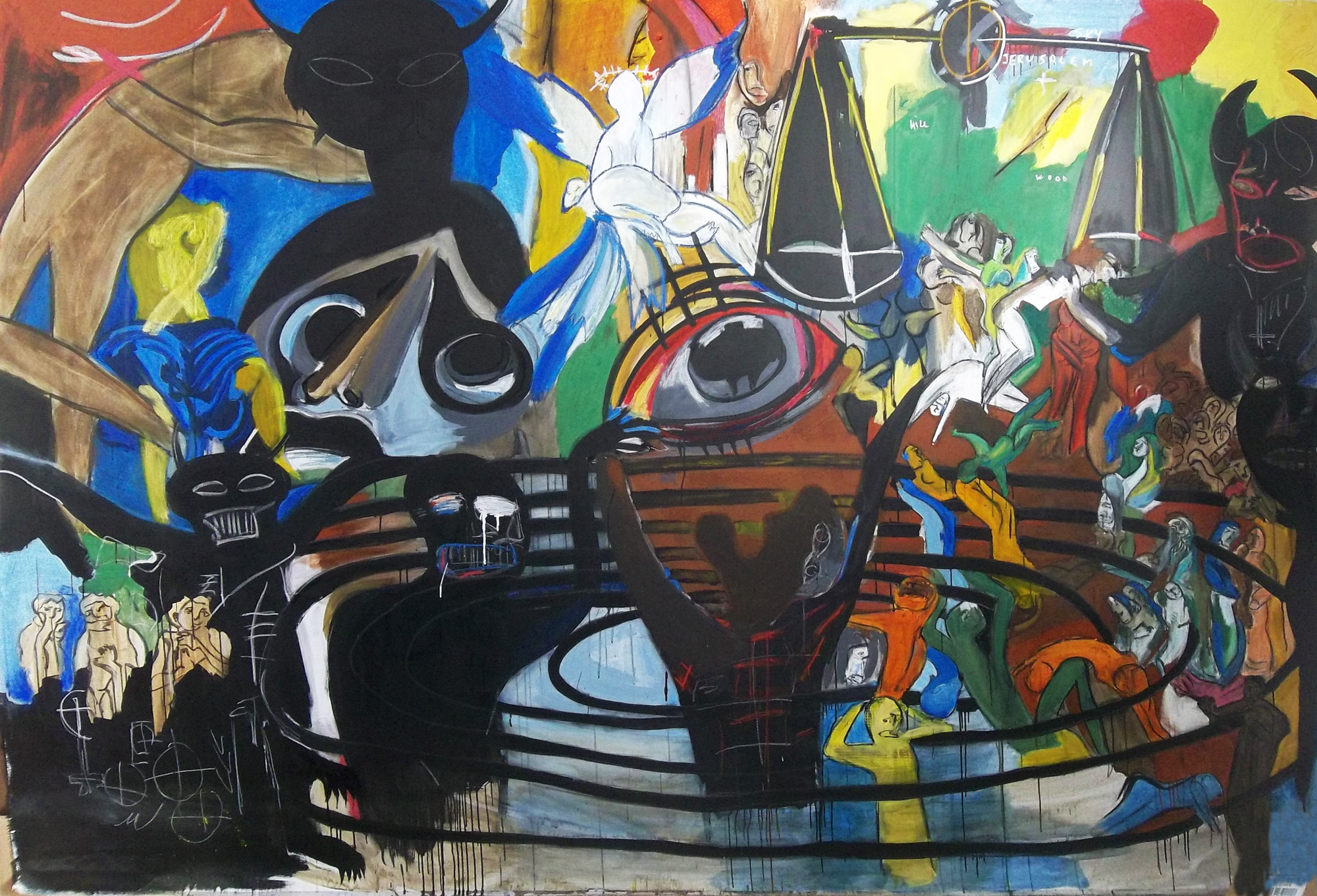“Of this work, Schroeder writes: ‘After reading The Divine Comedy, I was interested in having my own version of Hell and its different circles… I wanted my version more like a play than a painting. I wanted to describe all the mixed feelings in Hell: justice, tears, cries, desperation, evil, suffering, redemption and sorrows. For me, Hell is not necessarily black and dark… The use of colors is also to illustrate the three parts of the poem: Hell, Purgatory and Heaven. My Inferno becomes a ballet where souls, evils, judgments and penalties are mixed… Maybe we can be better and win our place in Heaven walking through the Good and The Bad. Our souls can be delivered from evil through this long and hard journey. My Inferno is a theatre, a global vision of Hell and its circles, but also a sacred song of redemption.'” —Artistic Interpretations: Frank Schroeder, Cornell University Library’s Visions of Dante Exhibition, curated by Andrew C. Weislogel and Laurent Ferri (2021; retrieved October 26, 2022)
Jems Robert Koko Bi, Convoi Royal (2009)
“Dante’s journey paints a fine portrait of the world I was living in when Convoi Royal was created. This time, the world is a lot like reality. A world running a merciless race, steered by wild beasts devouring everything in their way. The huge hooves hammer the ground, chipping it away to form an infernal whirlpool. The earth trembles with each thud, tilts, and is thrown off balance. A terrible panic strikes its inhabitants. They raise their arms to shield their heads, run around in a crazed fray, seeking temporary shelter. In the beginning, these wild animals were normal beings whose duty was to ensure a better future for the world, but their stomachs were too empty and their prey too easy for this duty to be respected. They decided to satisfy their ego instead, rather than work for the well-being of their numerous fellow beings who were famished and dying. The unknown paradise started its royal convoy. Backed up against the wall, I resign myself to a constraint, deadly as it may be: to leave.” –Jems Robert Koko Bi
Retrieved from The Divine Comedy: Heaven, Purgatory, and Hell Revisited by Contemporary African Artists by Simon Njami.
For more information on the Ivorian artist, see Wikipedia. For more information on Convoi Royal, visit the link here.
Kader Attia, Dispossesion (2013)
“Soul—the term occurs often, meant in a rigorously philosophical sense as a ‘vital principle’ or ‘bodily entelechy.’ Just like all the medieval masters, Dante sees in man a being made up of both body and soul. As regards the relationship between the two components, Dante sticks to the Aristotolean solutions, adopted unanimously by the theologians of the day. Hence, the soul may be conceived and represented as separate from the body, in its definitive condition of a dweller in the kingdoms of the afterlife. In this sense, the term is used countless times to refer to the shadows of the dead in their concrete individuality: ‘O spirit courteous of Mantua’ (Inferno, Canto II, 58); ‘But all those souls who weary were and naked,/Their colour changed’ (Inferno, Canto III, 100).”
Retrieved from The Divine Comedy: Heaven, Purgatory, and Hell Revisited by Contemporary African Artists by Simon Njami.
For more on the French-Algerian artist Kader Attia, see Wikipedia.
Pascale Marthine Tayou, Sisiphe remontant le tarmac (2013)

“Miserere—In vulgar Latin, it is the first word of Psalm 50: ‘Miserere mei, Deus, secundum magnam misericordiam tuam,’ used in the Catholic liturgy in funeral services, in the rites of Lent and the Holy Week, and generally in the orations of penitence. The penitential psalm is sung in the Comedy by the rows of the dead, in the second terrace of Ante-Purgatory, and the chant, is recited in alternate verses (‘singing the “Miserere” verse by verse’ [Purgatorio, Canto V, 24]), is interrupted by an exclamation of astonishment when the souls realize from his shadow that Dante is alive. In a rather different context, however, the expression ‘Miserere mei’ is cried out by Dante at the appearance of Virgil’s shadow in the forest (Inferno, Canto I, 65).”
Retrieved from The Divine Comedy: Heaven, Purgatory, and Hell Revisited by Contemporary African Artists by Simon Njami.
For more on the Cameroonian artist Pascale Marthine Tayou, see Wikipedia.
Kudzanai Chiurai, Charity (2013)

“Dante echoes Saint Paul (Rom. 5:1-5) when he shows charity as born of hope, in turn generated by faith. These three virtues sum up all the celestial philosophy and constitute the very condition of salvation. Within the doctrinal field, the word indicates the fundamental attitude of the Father towards all His creatures, a relationship that finds its perfect form in the blessed [. . .] (Purgatorio, Canto XV, 71).”
Retrieved from The Divine Comedy: Heaven, Purgatory, and Hell Revisited by Contemporary African Artists by Simon Njami.
To learn more about the Zimbabwean artist and activist Kudzanai Chiurai, see Wikipedia. Read an interview with the artist about his related 2012 video work Iyeza on the RISD Museum blog.
- 1
- 2
- 3
- …
- 6
- Next Page »



